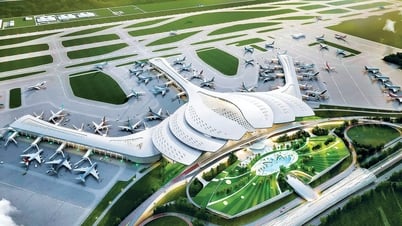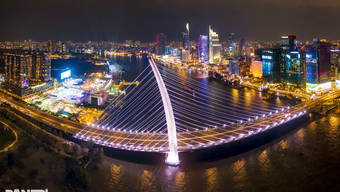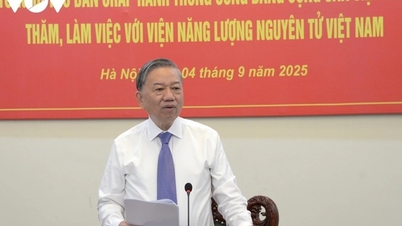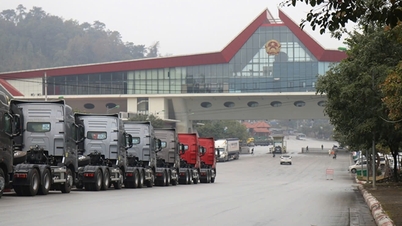(PLVN) - Vietnam's airport system is witnessing strong development with key projects. However, besides positive signs, the aviation industry still faces the "problem" of overload, infrastructure has not kept up with growth rate and urbanization pressure.
 |
| 2025 is forecast to continue to be a positive year for air transport, especially international air transport. |
(PLVN) - Vietnam's airport system is witnessing strong development with key projects. However, besides positive signs, the aviation industry still faces the "problem" of overload, infrastructure has not kept up with growth rate and urbanization pressure.
Hub-spoke planning
In recent years, Vietnam's aviation industry has continuously made strong and breakthrough developments, playing an important role in connecting the economy , tourism and international trade. With the increasing demand for travel and freight transport, the airport system has become an indispensable lifeline of the economy.
According to statistics, up to now, Vietnam has 22 airports, including 12 international airports and 10 domestic airports. Major international airports such as Tan Son Nhat (HCMC), Noi Bai (Hanoi), Da Nang (Da Nang), ... play an important role in building a bridge connecting the country with friends around the world, creating favorable conditions for tourism , trade and international trade. Domestic airports also play a role in ensuring the connection between regions in the country.
Our country's airport system is planned according to the hub-spoke model with two main hubs being Hanoi and Ho Chi Minh City, from which it spreads connections to regions through a network of satellite airports. This is a reasonable model to optimize accessibility and serve the needs of trade, tourism as well as socio-economic development.
However, the suitability of airport locations depends not only on planning theory but also on practical exploitation, geographical conditions and urbanization pressure. For example, Tan Son Nhat is located right in the heart of Ho Chi Minh City, about 8km from the center, providing an outstanding advantage in travel time for millions of passengers each year. However, this makes the expansion space narrow, causing noise and making it difficult to upgrade infrastructure. Other international airports such as Van Don or Phu Quoc have strategic locations, serving tourism and the marine economy, but have not been fully exploited due to low transportation demand. Meanwhile, domestic airports such as Dien Bien, Con Dao... were built to serve remote areas, however, the rugged terrain and sparse population in these areas make regular operations difficult, leading to low exploitation efficiency.
The "overloaded" chorus
Regarding passenger and cargo transport output, according to the report of the Vietnam Airports Corporation (ACV), in 2024, the total number of passengers passing through airports will reach 109 million, including 41 million international passengers and 68 million domestic passengers. The total number of parcels passing through the ports will reach 1,505 tons. Despite these remarkable results, there are still some typical difficulties such as the fact that major airports are always overloaded, and this is no longer a new problem.
Specifically, during peak periods such as the recent Lunar New Year (January - February 2025), Tan Son Nhat Airport recorded more than 4 million passengers in just one month, showing that the current capacity is gradually approaching the maximum response threshold. With an initial design capacity of 25 million passengers/year, Tan Son Nhat served more than 41 million passengers in 2019 and has continued to be under great pressure in recent years. While waiting for the completion of the construction of Terminal T3 (expected to be put into operation on April 30, 2025) with a capacity of 20 million passengers/year, congestion during peak hours at Tan Son Nhat Airport still occurs frequently.
Similarly, Noi Bai airport has also exceeded its pre-Covid-19 peak, with its operating capacity pushed to its limits. Other airports such as Da Nang, Cam Ranh, and Phu Quoc are also starting to show signs of overload during the peak tourist season. The main cause of the overload is infrastructure that has not kept up with the "hot" growth rate of the aviation industry. The runway, taxiway, and parking systems at major airports such as Tan Son Nhat are no longer suitable for current needs. In addition, the shortage of aircraft due to engine recalls and global supply shortages has further increased pressure on airports.
To address the overload situation and improve the ability to meet transportation needs, Vietnam is focusing on two main solutions: upgrading existing infrastructure and building new airports.
Source: https://baophapluat.vn/cang-hang-khong-viet-nam-nhung-gam-mau-sang-toi-post541281.html



![[Photo] Politburo works with the Standing Committee of Can Tho City Party Committee](https://vphoto.vietnam.vn/thumb/1200x675/vietnam/resource/IMAGE/2025/9/4/10461762301c435d8649f6f3bb07327e)
![[Photo] Politburo works with the Standing Committee of the Party Committee of the Fatherland Front and Central organizations](https://vphoto.vietnam.vn/thumb/1200x675/vietnam/resource/IMAGE/2025/9/4/6f23e5c0f576484bb02b3aad08f9d26a)

![[Photo] Prime Minister Pham Minh Chinh chairs the thematic meeting on law making in August 2025](https://vphoto.vietnam.vn/thumb/1200x675/vietnam/resource/IMAGE/2025/9/4/ba42763cd48e4d7cba3481640b5ae367)
![[Photo] Politburo works with the Standing Committee of Lai Chau Provincial Party Committee](https://vphoto.vietnam.vn/thumb/1200x675/vietnam/resource/IMAGE/2025/9/4/f69437b9ec3b4b0089a8d789d9749b44)

























































































Comment (0)